Styrax, Storax, Su He Xiang 苏合香Rosa MallasSu He Xiang (TCM) Salaras, Asl Labni (Unani) |

|
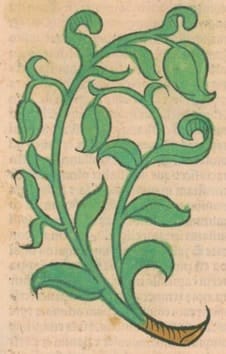 Ortus Sanitatis, Meydenbach, 1491
Ortus Sanitatis, Meydenbach, 1491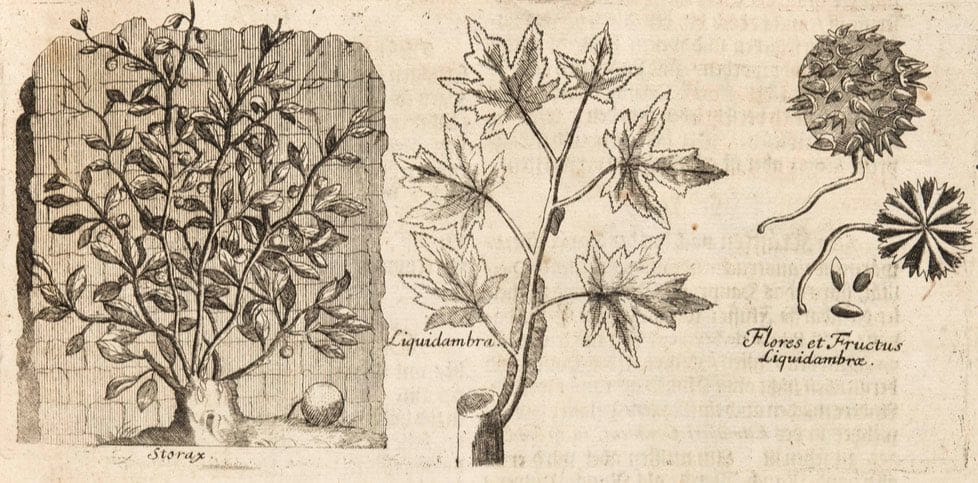 Left: Styrax officinalis (ancient source); Center & Right: Liquidamber (modern source)
Left: Styrax officinalis (ancient source); Center & Right: Liquidamber (modern source)Museum Museorum, Valentini, 1704
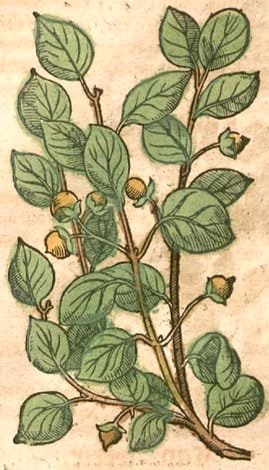 Styrax officinalis
Styrax officinalisMedical Botany, Woodville, 1810
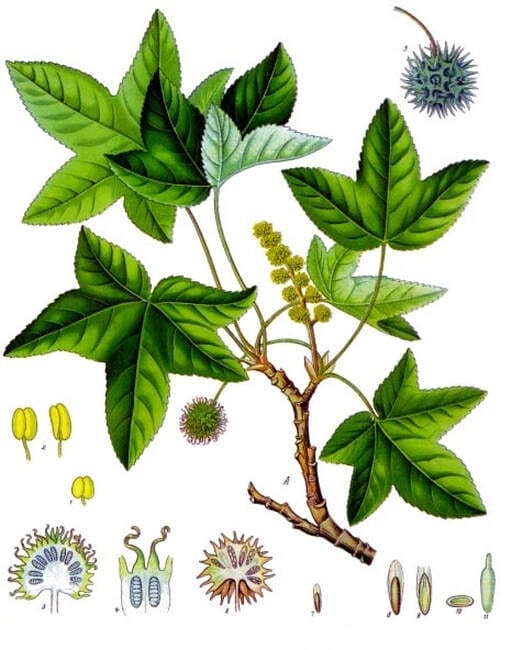 Liquidambar orientalis, the modern source of Storax
Liquidambar orientalis, the modern source of StoraxKöhler’s Medizinal-Pflanzen, 1897
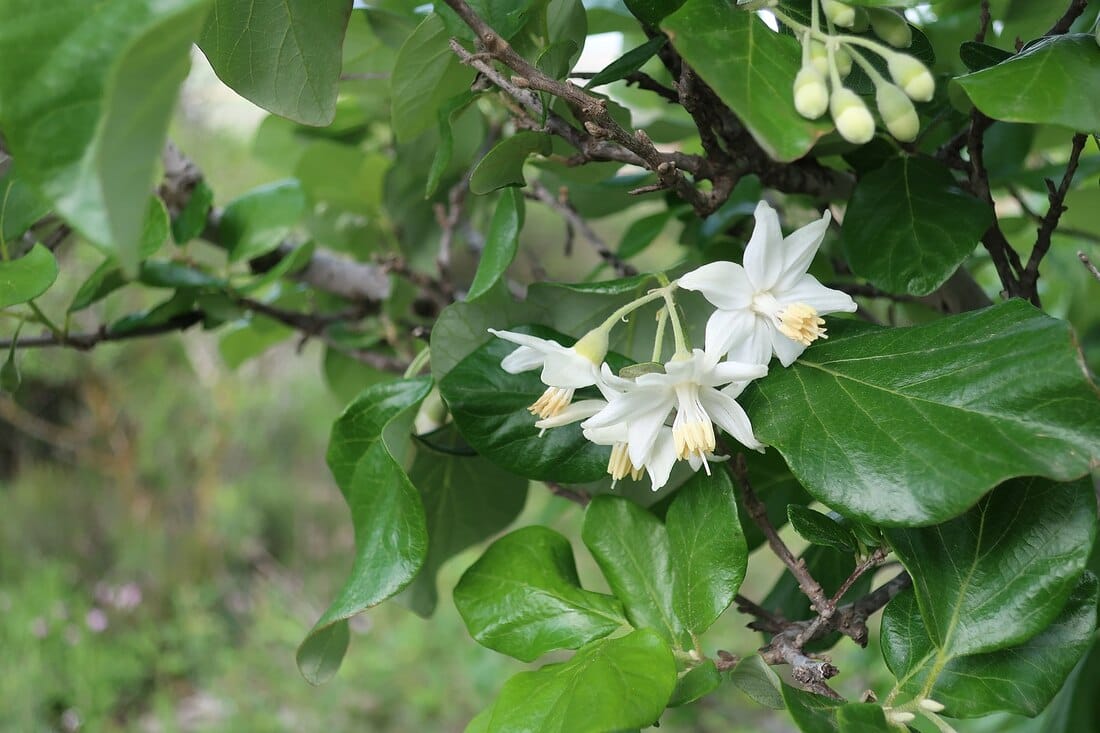 Styrax officinalis
Styrax officinalis(Photo by Davidbena) (Wikimedia) |
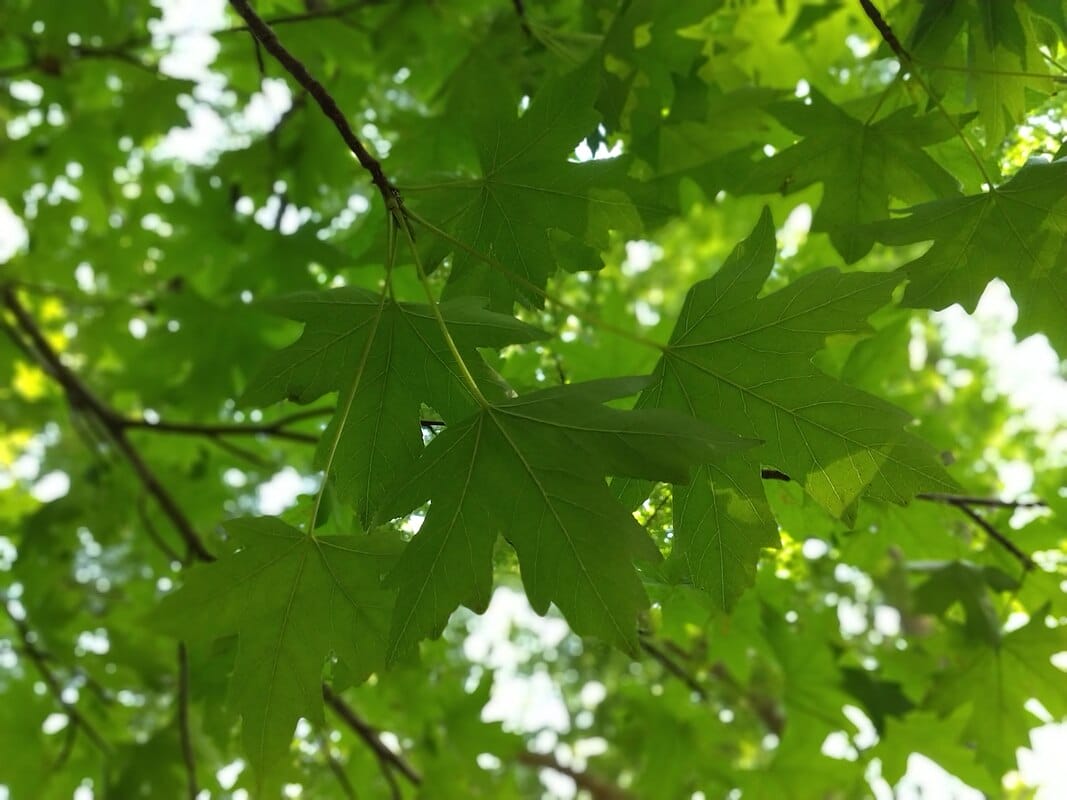 Liquidambar orientalis
Liquidambar orientalis(Photo by Rohit Naniwadekar) (Wikimedia) |
 Members CLICK HERE for the PRO VERSION
Members CLICK HERE for the PRO VERSIONBotanical name:
Styrax officinalis
The official product as used in antiquity is largely unavailable on the modern market.
Today, Storax is supplied by various plants:
- Liquidambar orientalis (Liquid Storax) supplies the market today (Turkey, Greece)
- L. formosana (Chinese Storax)
- L. styraciflua (American)
- Altingia excelsa also supplies the modern Storax (especially in India)
Parts used:
Gum; Dry (Storax Calamita) and Liquid Storax was used
Temperature & Taste:
Warm, dry. Pungent, Aromatic
Classifications:
2H. CARMINATIVE. 2L. EMOLLIENT. 2U. SUPPURATIVE. 2V. EXPEL PUS
3D. CORDIALS & CARDIACS. 3L. ANTI-TUSSIVE.
4a. CEPHALIC. 4c. CARDIAC. 4e. STOMACHIC. 4k. ARTHRITIC
Exhilarative
TCM:
J. Aromatics that Open the Orifices
Uses:
1. Opens the Orifices, Clears the Mind, Clears Wind and Phlegm:
-loss of consciousness
2. Moves the Blood, Opens Obstructions, Clears Wind-Phlegm:
-heart disorders such as Angina, Coronary Heart Disease etc.
3. Warms the Lungs, Clears Phlegm:
-Coughs, Hoarseness
4. Resists Poison.
5. Yogavaha:
-enhances the effect of medicines it is combined with.
6. Externally:
-in cosmetics to improve skin tone.
Dose:
Liquid Storax: 1–4 grams
Dry Storax: 500mg–2 grams
Correctives:
… available in PRO version
Substitutes:
… available in PRO version

Main Combinations:
Benzoin & Storax
1. Hoarseness, tickling sore Throat, Storax with … available in PRO version
2. Catarrh, Storax with … available in PRO version
3. Asthma and Bronchitis, Storax with … available in PRO version
4. Stroke associated with Wind-Phlegm:
i. Storax, … available in PRO version
ii. Storax, … available in PRO version
iii. Storax, … available in PRO version
5. Heart Disease and Angina Pectoris:
i. Storax, … available in PRO version
ii. Storax, … available in PRO version
iii. Storax, … available in PRO version
iv. Storax, … available in PRO version
v. Storax with … available in PRO version
vi. Storax, … available in PRO version
6. Chest and abdominal pain from Cold-Phlegm:
i. Storax with … available in PRO version
ii. Storax with … available in PRO version
Major Formulas:
Powder of Happiness (Letificans)
New Rose Powder (Rosata Novella) (Nicolas)
Surgeon’s Musked Troches (Alipta Muscata) (Nicholas)
Antidote Appropriate for Cough (Nicholas)
Antidote Proven for Diverse Diseases (Nicholas)
Triphera Greater (Nicholas)
Electuary of Orris Root (Diaireos Salomonis) (Nicholas)
Electuary of Frankincense (Diaolibanum) (Nicholas)
Restorative Electuary (Antidotus Analeptica) (Nicholas)
Pills of Storax (Mesue)
Expert Pills for Cough
Pills Proven for Coughs (Galen)
Su He Xiang Wan
Shi Xiang Fan Sheng Wan
Cautions:
1. Generally not used during Pregnancy.
2. Not used in Coma associated with High Fever
3. Pliny said moderate doses dispel Melancholy, large doses causes it.
Main Preparations used:
Distilled Oil
-
Extra Info
-
History
-
Varieties
‘In speaking too of the exotic trees, we have made mention of the properties of storax. In additiont ot hose which we have already mentioned, it ought to be very unctuous, without alloy, and to break to pieces in whitish fragments. This substance is curative of cough, affections of the fauces, diseases of the cheat, and obstructions or indurations of the uterus. Taken in drink, or employed as a pessary, it acts as an emmenagogue; it has a laxative effect also upon the bowels. I find it stated that, taken in moderate doses, storax dispels melancholy; but that when employed in large quantities, it promotes it. Used as an injection it is good for singings in the ears, and employed as a friction, for scrofulous swellings and nodes of the sinews. It neutralizes poisons of a cold nature, and consequently, hemlock.’ (The Natural History of Pliny, trans. by Bostock and Riley, Vol. 5, 1856)
1. Storax
|
‘Two substances of different origin have been known from a remote period under the name of Styrax or Storax, namely the resin of Styrax officinalis L., and that of Liquidambar orientalis Miller, the latter commonly distinguished as Liquid Storax. According to Krinos of Athens, who has carefully investigated the history of the drug, the earliest allusions to Liquid Storax occur in the writings of Aetius and of Paulus Aegineta, who name both Storax and Liquid Storax. Of these Greek physicians, who lived respectively in the 6th and 7th centuries, the second also mentions the resin of [?], which is regarded by Krinos as synonymous with the latter substance. We find in fact the term Sigia frequently mentioned by Rhazes (10th century) as signifying Liquid Storax. This and other Arabian physicians were also familiar with the same substance under the name of Miha (may’a), and also knew how and whence it was obtained. A curious account of the collecting of Liquid Storax from the tree Zygia, and from another tree called Stourika, is given in the travels through Asia Minor to Palestine of the Russian abbot of Tver in A.D. 1113-1115. The wide exportation and ancient use of Liquid Storax are very remarkable : even in the first century, as appears by the author of the Periplus of the Erythrean Sea, Storax, by which term there can be but little doubt Liquid Storax was intended, was exported by the Red Sea to India. Whether the Storax and Storax Isaurica offered to the Church of Rome under St. Silvester, A.D. 314-335, by the emperor Constantine, |
was Liquid Storax or the more precious resin of Styrax officinalis L., is a point we cannot determine, That the Chinese used the drug was a fact known to Garcia de Orta (1535-63): Bretschneider has shown from Chinese sources that, together with olibanum and myrrh, it was imported by the Arabs into China during the Ming dynasty, A.D. 1368-1628. This trade is still carried on: the drug is conveyed by way of the Red Sea to Bombay, and thence shipped to China. Official returns show that the quantity thus exported from Bombay in the year 1856-57 was 13,328 Ib. In the time of Kampfer (1690-92), Liquid Storax was one of the most profitable articles of shipment to Japan. Liquid Storax is known in the East, at least in the price-currents and trade statistics of Europeans, by the strange-sounding name of Rose Mottoes (Rosa Alattas, Rosum Alloes, Rosmal),a designation for it in use in the time of Garcia de Orta. Clusius considered it to be Arabic, which, however, the scholars whom we have consulted do not allow. Others identify it with Rasamala, the Malay name for Altingia excelsa. The botanical origin of Liquid Storax was long a perplexing question to pharmacologists. It was correctly determined by Krinos, but his information on the subject published in a Greek newspaper in 1841, and repeated by Kost in 1855, attracted no attention in Western Europe. The question was also investigated by one of the authors of the present work, whose observations, together with a figure of Liquidambar orientalis Miller, were published in 1857.’ (Pharmacographia, Fluckiger & Hanbury, 1879) |
2. Storax Calamita
|
‘Styrax Calamita (Storax en pain Guibourt)—The substance that now bears this name is by no means the Styrax Calamita of ancient times, but is an artificial compound made by mixing the residual Liquidambar bark called Cortex Thymiamatis, coarsely powdered, with Liquid Storax in the proportions of 3 to 2. It is at first a clammy mass, acquiring after a few weeks an appearance of mouldiness, due to minute silky |
crystals of styracin. It is usually imported in wooden drums, and has a very sweet smell. When the bark is scarce, common sawdust is substituted for it, while qualities still inferior are made up with the help of olibanum, honey, and earthy substances. This drug is manufactured at Trieste, Venice and Marseilles’. (Pharmacographia, Fluckiger & Hanbury, 1879) |
3. Liquid Storax
|
‘Liquid storax is prepared in the South Western Districts of Asia Minor by boiling the inner bark of the tree in water and pressing it; a superior kind is said to be obtained by simply pressing the bark before it is boiled. We learn from the author of the Periplus of the Erythrean Sea that as long ago as the first century Storax was exported by the Red Sea to India. It was probably carried first to this country and afterwards to China by the Arab traders in the same manner as myrrh, olibanum and other odoriferous drugs. Upon the decline of the port of Surat the trade was transferred to Goa, and afterwards to Bombay, where it still continues, the imports averaging from 350 to 360 cwts. yearly. In the trade statistics of the early European traders it is called Rosa Mallas and Rosa Malloes, a name which it still retains, and the origin of which is doubtful, though some suppose it to be identical with Rasa-mala, the Malay name for Altingia excelsa. That the latter supposition is incorrect I think there can be little doubt as the only Rose malloes known in Bombay is that imported from Europe. The following extracts will, I think, show that the name is of European origin, and has been applied to Liquid Storax incorrectly through a confusion of that substance with the Honey dew or Manna collected from trees, the [?] of the Greeks and the Ros melleus of the Middle Ages. Galen speaking of [?] says :— “I have sometimes known in summer a large quantity of honey to be found upon the leaves of trees, shrubs and certain herbs,” &c. Ibn Sina says of Storax:— “One sort exudes from the tree and the other is obtained by boiling, the former is of a light colour and very valuable, the other dark and of less value.” Serapion and Ibn Zakarieh (Rhazes) have the same account of it. According to Abu Hanifeh (Liquidambar orientalis) is of the trees of the mountains, and is like the great oak, having clusters (of berries) like those of the oak, but its berries are larger; its leaves are cooked, and when thoroughly cooked, are cleared away and the water thereof is returned to the fire, and coagulates, becoming like ‘Kubaita‘ (a kind of sweetmeat), and is used medicinally as a remedy for roughness of the chest, and for pain of the fauces. Ibn Sina, Serapion and Zakarieh mention a manna which falls upon trees, and especially upon thorns, it is called Turanjabin, and has gentle purgative properties; it is expectorant, and softens the throat and chest. Ibn Baitar says:– |
“Rosmelleus is a substance which falls upon trees in Khorasan; it is useful in fevers, it moistens the chest, is detergent, &c. The author of the Tuhfat-el-Muminin says :— Daru or Zaru is the name of an Arabian tree like the oak; its fruit is like that of the Butin (Pistacia terebinthus), but its seeds are larger, the gum of this tree is storax (Hassi luban), and has already been noticed. The wood, leaves and fruit are hot and dry, and a decoction of them with sugar, when brought to the consistence of a syrup by boiling, is used for roughness of the throat and cough. The oil of the seeds is odoriferous and dissolves phlegmatic humours; it is useful in dyspepsia, and in the scabby eruptions of animals (mange). The author of the Makhzan-el-Adwiya says :— “Rasimilius is a Greek name for a kind of incense called in Arabic [?] and in Hindi [?] (Western Frankincense).” In another place, speaking [?], he says the Greek name is Fazukus [?]. In Bombay it is always called Silaras, and is noticed in Sanskrit works as Silhaka, and described as a product of Turkey. The Hindus use it chiefly for perfuming medicinal oils, but are aware of its pectoral qualities, and occasionally prescribe it. In Arabic and Persian works Liquid Storax is called Meah-sayelah and Lubni, and is described as the gum or juice of a tree resembling the quince. Three kinds are generally mentioned— viz., 1st, that which exudes naturally; 2nd, that which is obtained by pressing the bark; and 3rd, that which is obtained by boiling it. These three kinds, however, are not at the present time distinguished in commerce in Bombay, though the article may vary in quality considerably. Storax is considered by the Mahometans to be tonic, resolvent, suppurative, and astringent; it is prescribed as a pectoral, and is thought to strengthen all the viscera ; applied externally it is supposed to have a similar action upon the parts with which it comes in contact. It is a favourite application to swellings, and in Bombay is much used in orchitis, the inflamed part being smeared with it and then bound up tight in tobacco leaves. The Burmese Storax noticed in the Pharmacopoeia of India is not known in Bombay. Much interesting information regarding the history and sources of Storax may be found in the Pharmacographia‘. (Vegetable Materia Medica of Western India, Dymock, 1885) |
